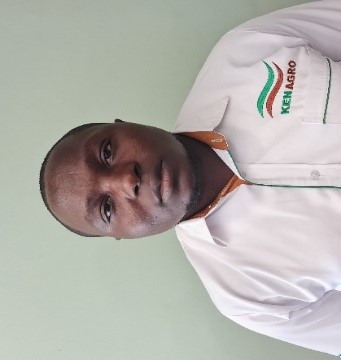
Jeremiah Mwendwa Kawai is 29 years old. He was born on March 09, 1994. He is the eleventh of his parents' twelve children. His parents are the late Benson Kawai Mukuthi and the late Rodah Kanyiva. We live at our village home at Mbole village, Nguu sub-location in Makueni County. He attended his secondary Education in Kabaa High School and his primary school in Nguma primary school. He acquired his undergraduate degree (BSc Agriculture) from the University of Nairobi in 2017. He has worked as a primary school teacher and also a secondary school teacher. He has always wanted to be a teacher. He is good story teller. Honesty and leadership are his personal traits. He developed passion for Agriculture back in high school. He is an agronomist. He is currently working as a senior agronomist for Kenagro suppliers ltd. His long term goal is to advise the government on avenues to food security.
Abstract
Green gram (Vigna radiate (L) is among the most widely consumed legumes in Kenya. Root rot of green grams caused by Fusarium oxysporum has been documented as the major biotic challenge during the production of the legume crop. It causes a loss between 10-100% in green gram yields. Chemical and cultural practices used in root rot management have several limitations including high cost, harmful effects to the environment, hazard to human and animal health. This study specifically focused on use of biological control agents in the management of green gram root rot caused by Fusarium oxysporum. Trichoderma and Bacillus isolates were first screened in vitro against Fusarium oxysporum and then in the green house and in the field. Twenty-two species of Trichoderma and nineteen species of Bacillus were provided by Prof. Mutitu from the Department of Plant Science and Crop Protection, University of Nairobi to be used as the antagonists. The level of antagonism was assessed by measuring the radius of the zone of inhibition of the fungal pathogen due to the presence of the antagonists. The green house and the field experiment were conducted at Kabete in Kenya using a two-way factorial design. The treatments were a chemical standard and two Trichoderma isolates (T2 and T3). The Trichoderma isolates were grown on sterile dehulled rice, cow manure and goat manure. The incidence and severity of root rot was determined by observation of the symptoms on roots. The assessment of severity and incidence was carried on the 7th week after inoculation of the green gram plants. The quantification of the yield was assessed by counting the number of pods per plant, and then the average number of pods calculated. Plant height was measured linearly in centimetres from the crop base to the top. Results from in vitro studies showed the Trichoderma and Bacillus variedly inhibited growth and sporulation of Fusarium oxysporum. The treatments evaluated under both greenhouse and field conditions significantly reduced root rot severity at p≤0.05 in comparison with the untreated control at Kabete Field Station. Results from the study showed that Trichoderma isolates grown in appropriate carriers can be used effectively as biological control agents in the management of root rot of green grams.
Research Supervisors
Prof. Eunice W. Mutitu
Dr. William. M. Muiru
